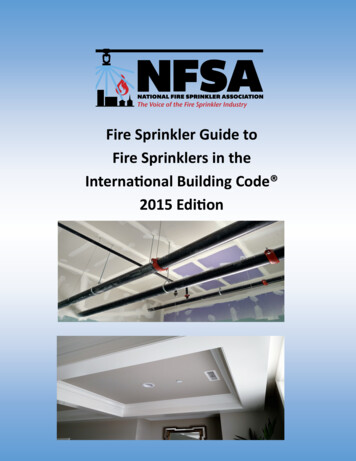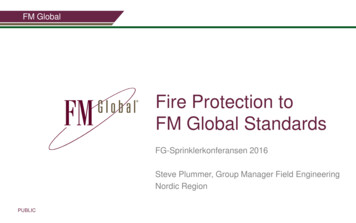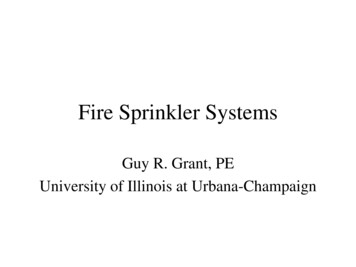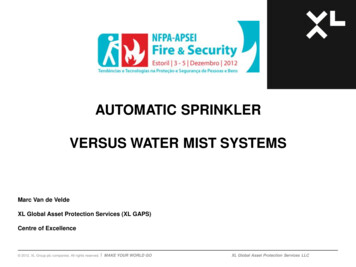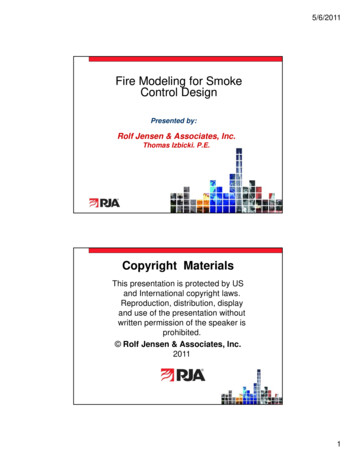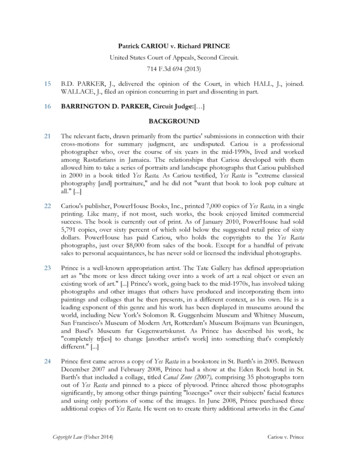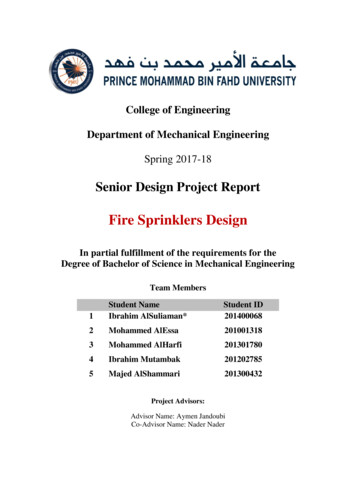
Transcription
College of EngineeringDepartment of Mechanical EngineeringSpring 2017-18Senior Design Project ReportFire Sprinklers DesignIn partial fulfillment of the requirements for theDegree of Bachelor of Science in Mechanical EngineeringTeam Members1Student NameIbrahim AlSuliaman*Student ID2014000682Mohammed AlEssa2010013183Mohammed AlHarfi2013017804Ibrahim Mutambak2012027855Majed AlShammari201300432Project Advisors:Advisor Name: Aymen JandoubiCo-Advisor Name: Nader Nader
AbstractA fire sprinkler framework is a dynamic fire assurance technique, comprising of a watersupply framework, giving sufficient weight and stream rate to a water circulation-channelingframework, onto which fire sprinklers are associated. Also it is utilized as a part of processingplants and substantial business structures, frameworks for homes and little structures arepresently accessible at a practical cost. Fire sprinkler frameworks are broadly utilized aroundthe world, with more than 40 million sprinkler heads fitted every year. In structures totallysecured by flame sprinklers alone controlled sprinkler frameworks, more than 96% of flames.Sprinklers have been being used in the United States since 1874, and were utilized as a partof manufacturing plant applications where fires when the new century rolled over wereregularly disastrous as far as both human and property losses. In the US, sprinklers are todayrequired in all new skyscraper and underground structures for the most part 75 feet (23 m)above or beneath flame office get to, where the capacity of firefighters to give sufficient hosestreams to flames is restricted. [1]Sprinklers might be required to be introduced by construction standards, or might beprescribed by insurance agencies to decrease potential property losses or business intrusion.Construction standards in the United States for spots of gathering, by and large more than 100people, and places with overnight dozing convenience, for example, hotels, nursing homes,residences, and hospitals ordinarily require sprinklers under nearby building regulations, as astate of accepting State and Federal financing.In this Project, the aim is to develop a simple Fire Sprinkler, where the sprinkler can betested. The test of the sprinkler is to be by connecting the pipes and the reservoir that containsthe water and how the breaking of the chemical tube is happening as if there is a real fireoccurring in a building. Further studies will include the calculations of the radius and the areathat one sprinkler can handle during a fire case and how many one we have to install in abuilding to cover the fire as a given flow rate and pressure [2].2
AcknowledgmentsThis work would not have been possible without the support of Prince MohammadUniversity and the Mechanical Engineering professors whom helped developing the FireSprinklers. I am especially indebted to Dr. Aymen Jandoubi and Dr. Nader Nader who havebeen supportive of my project and who worked actively to provide me with the protectedacademic time to pursue those goals. I am grateful to all of those with whom I have had thepleasure to work during this and other related projects. Each of the members of ASME PMUChapter has provided me extensive personal and professional guidance and taught me a greatdeal about both scientific research and life in general. As my teacher and mentor, he hastaught me more than I could ever give him credit for here. He has shown me, by his example,what a good researcher should be. Nobody has been more important to me in the pursuit ofthis project than the members of my family. I would like to thank my parents, whose love andguidance are with me in whatever I pursue. They are the ultimate role models [3]3
List of Acronyms (Symbols) used in the report :National Fire Protection Association (NFPA)Early Suppression Fast Response (ESFR)National Institute for Certification in Engineering Technologies (NICET)American Society of Mechanical Engineering (ASME)4
List of Figures:Figure 1Figure 2Figure 35
Table of ContentsAcknowledgments . 3List of Acronyms (Symbols) used in the report . 4List of Figures: . 5List of Tables . Error! Bookmark not defined.Chapter 1: Introduction. 81.1Project Definition. 81.2Project Objectives . 81.3Project Specifications . 91.4Applications: . 11Chapter 2: Literature Review . 152.1Project background . 152.2Previous Work . 162.3Comparative Study . 17Chapter 3: System Design . 193.1Design Constraints and Methodology . 193.1.1Constraints . 203.1.2Design Methodology. 223.2Engineering Standards . 253.3Theory and Theoretical Calculation. 263.3.13.4velocity calculation . 27Product Subsystems and selection of Components . 283.4.1Sprinkler head . 283.4.2Glass bulb . 283.4.3Seal . 283.5Manufacturing and assembly (Implementation) . 293.5.1Sprinkler system (assembly) . 293.5.2Glass bulb . 293.5.3Seal . 30Chapter 4: System Testing and ------------------------------------314.1 Experimental Setup, Sensors and data acquisition system . 314.2Results, Analysis and Discussion . 32Chapter 5: Project ---355.1 Project -------------355.2 Contribution of -365.3 Project Execution 5.4 Project Bill of Materials and ------------------------------------38Chapter 6: Project Analysis . 39Life Long Learning. 391.1.1Improve our Skills in Some Software Tools . 391.1.2Time Management Skill . 391.1.3Problem Solving . 30Impact of Engineering Solutions . 401.1.4Society . 406
1.1.5Environment . 401.1.6Economy . 40Contemporary Issues Addressed . 40Chapter 7: Conclusions and Future Recommendations . 428.7.1Conclusions . 427.2Future Recommendations . 42References . 447
Chapter 1: Introduction1.1Project DefinitionThis project is intended to design and manufacture a simple Fire Sprinklers, where the firesprinkler can be inserted and tested. The test fire sprinkler is to be fitted with pipes andconnections along with the tube bulb that could be exchangeable for many number of testingin which we can show it many times and change the bulb every time we test. The project isvery important to the industries, as through understanding the characteristics of differenttypes of the fire sprinklers so that we could be able to use every one in their specific locationand task. This is also very important from the safety prospective as this will lead to a safesocial environment to cover many areas such as operation plants, schools, hospitals gasstations and more. The project will show more details about the specifications and dimensionand radius of covering the area of the intended to put the fire off of it. Also to show thestudents how the fire sprinklers working mechanism occurs and how does it really work. Alsoto demonstrate the different kinds of the distribution flow of the nozzle that could give moreefficient and effective result as they could be varied with the environment and the nature ofthe place or building. For example, school would have different type of fire sprinklers thanthe chemical industry and so the flow rate and the medium used to put the fire such as Foam,Water and weather it will be wet or dry, as we will see later on [4].1.2Project Objectives:1. Design and construct a Fire Sprinklers to show flow rate and pressure distributing forfire detected in school or hospital or chemical industry using specific type of sprinkles2. Study the change in different types of the Fire Sprinklers and how they can be moreefficient for their designated area and field.3. Relate different type and medium used in different weather and conditions dependingon the environment and needs.4. Developing fire sprinklers distribution techniques to prevent huge uncontrolled fire tobe put off without the need to make firefighters possess more danger and lessen theirexposure to fire as much as possible.8
1.3Project SpecificationsFigure 4Figure 6Figure 5Figure 6Some of the most important aspect we have to consider is the ceiling height in which ithas the means of egress shall have a ceiling height of not less than 7 feet 6 inches (2286mm). Other things to consider is the number of occupant in the room and it would becalculated and figured upon the table shown below as the standard of NFPA [4].9
Table 710
1.4Applications:There are many applications that can be differs depending on the type and weathercondition of the environment such as gas station in Alaska would use a type called Dry-PipeSystem in which the medium will not be subjected to be frozen and at the same time we keepthe sprinklers ready to be used. So there are many types of the Fire Sprinklers and on whichthe applications will be depending on it:1- Wet Pipe System:By a wide edge, wet pipe sprinkler frameworks are introduced more frequently than everysingle other sort of flame sprinkler frameworks. They likewise are the most solid, since theyare basic, with the main working segments being the programmed sprinklers and (normally,however not generally) the programmed alert check valve. A programmed water supply giveswater under strain to the framework funneling [4].2- Dry Pipe System:Dry pipe frameworks are the second most basic sprinkler framework write. Dry pipeframeworks are introduced in spaces in which the surrounding temperature might besufficiently chilly to solidify the water in a wet pipe framework, rendering the frameworkinoperable. Dry pipe frameworks are regularly utilized as a part of unheated structures, inparking structures, in outside shelters connected to warmed structures (in which a wet pipeframework would be given), or in refrigerated coolers. In areas utilizing NFPA directions,wet pipe frameworks can't be introduced unless the scope of encompassing temperaturesstays over 40 F (4 C) [4].Water is absent in the channeling until the point that the framework works; rather, thefunneling is loaded with air at a weight beneath the water supply weight. To keep the biggerwater supply weight from rashly constraining water into the channeling, the plan of the drypipe valve (a particular kind of check valve) brings about a more noteworthy power over thecheck valve clapper by the utilization of a bigger valve clapper zone presented to thefunneling gaseous tension, when contrasted with the higher water weight however littlerclapper surface region. When at least one of the programmed sprinkler heads is activated, itopens enabling the air in the channeling to vent from that sprinkler [4].3- Deluge System:"Storm" frameworks are frameworks in which all sprinklers associated with the waterfunneling framework are open, in that the warmth detecting working component is expelled,or particularly outlined all things considered. These frameworks are utilized for uniquedangers where fast fire spread is a worry, as they give a concurrent use of water over the11
whole peril. They are in some cases introduced in staff departure ways or building openingsto moderate go of flame (e.g. openings in a fire-evaluated divider).Water is absent in the funneling until the point when the framework works. Since thesprinkler openings are open, the funneling is at climatic weight. To keep the water supplyweight from compelling water into the channeling, a "downpour valve" is utilized as a part ofthe water supply association, which is a mechanically locked valve. It is a non-resettingvalve, and remains open once stumbled [4].Since the warmth detecting components introduce in the programmed sprinklers have beenevacuated (bringing about open sprinklers), the downpour valve must be opened as motionedby a fire caution framework. The sort of flame caution starting gadget is chosen for the mostpart in view of the danger (e.g. pilot sprinklers, smoke indicators, warm locators, or opticalfire finders). The start gadget flags the fire caution board, which thus flags the downpourvalve to open. Actuation can likewise be manual, contingent upon the framework objectives.Manual initiation is typically by means of an electric or pneumatic fire alert force station,which flags the fire caution board, which thusly flags the storm valve to open.Task - Activation of a fire caution starting gadget, or a manual force station, flags the firealert board, which thusly flags the storm valve to open, enabling water to enter the channelingframework. Water streams from all sprinklers at the same time [4].4- Pre-action System:Pre-activity sprinkler frameworks are particular for use in areas where incidentalenactment is undesired, for example, in exhibition halls with uncommon works of art,original copies, or books; and server farms, for security of PC hardware from unplannedwater release. Pre-activity frameworks are half and halves of wet, dry, and downpourframeworks, contingent upon the correct framework objective. There are two principle subsorts of pre-activity frameworks: single interlock, and twofold interlock [5]. The task ofsingle interlock frameworks are like dry frameworks aside from that these frameworksrequire that a "first" fire identification occasion, ordinarily the enactment of a warmth orsmoke locator, happens before the "activity" of water presentation into the framework'sfunneling by opening the pre-activity valve, which is a mechanically locked valve (i.e. like adownpour valve). Along these lines, the framework is basically changed over from a dryframework into a wet framework. The goal is to diminish the bothersome time postponementof water conveyance to sprinklers that is inborn in dry frameworks. Before flame recognition,if the sprinkler works, or the channeling framework builds up a break, loss of gaseous tension12
in the funneling will initiate an inconvenience alert. For this situation, the pre-activity valvewon't open because of loss of supervisory weight, and water won't enter the channeling [5].The task of Double interlock frameworks is like downpour frameworks with the exception ofthat programmed sprinklers are utilized. These frameworks require that both a "former" firelocation occasion, commonly the enactment of a warmth or smoke finder, and a programmedsprinkler task happen before the "activity" of water presentation into the framework'sfunneling. Actuation of either the fire finders alone, or sprinklers alone, without thesimultaneous activity of the other, won't enable water to enter the channeling. Since waterdoes not enter the funneling until the point when a sprinkler works, twofold interlockframeworks are considered as dry frameworks as far as water conveyance times, andcomparatively require a bigger plan zone.5- Foam Water Sprinklers System:A Foam water fire sprinkler framework is an extraordinary application framework,releasing a blend of water and low development froth think, bringing about a froth splashfrom the sprinkler. These frameworks are normally utilized with exceptional dangersinhabitances related with high test fires, for example, combustible fluids, and airplaneterminal storages. Task is as portrayed above, contingent upon the framework write intowhich the froth is infused [6].6- Water Spray:"Water spray" frameworks are operationally indistinguishable to a storm framework,however the channeling and release spout splash designs are intended to secure anexceptionally arranged peril, as a rule being three-dimensional parts or gear. The spoutsutilized may not be recorded fire sprinklers, and are generally chosen for a particular splashexample to fit in with the three-dimensional nature of the risk. Cases of dangers secured bywater splash frameworks are electrical transformers containing oil for cooling or turbogenerator heading. Water splash frameworks can likewise be utilized remotely on thesurfaces of tanks containing combustible fluids or gases, (for example, hydrogen). Here thewater splash is planned to cool the tank and its substance to forestall tank break/blast and firespread [7].7- Water Mist System:Water mist frameworks are utilized for extraordinary applications in which it is chosenthat making a warmth retentive vapor is the essential target. This sort of framework iscommonly utilized where water harm might be a worry, or where water supplies arerestricted. NFPA 750 characterizes water fog as a water splash with a bead size of "under13
1000 microns at the base activity weight of the release spout." The bead size can becontrolled by the changing release weight through a spout of a settled hole estimate. Bymaking a fog, an equivalent volume of water will make a bigger aggregate surface zonepresented to the fire. The bigger aggregate surface territory better encourages the exchange ofwarmth, along these lines enabling more water beads to swing to steam all the more rapidly.A water fog, which ingests more warmth than water per unit time, because of uncoveredsurface territory, will all the more successfully cool the room, in this manner lessening thetemperature of the fire. Activity - Water fog frameworks can work with an indistinguishableusefulness from downpour, wet pipe, dry pipe, or pre-activity frameworks. The distinction isthat a water fog framework utilizes a packed gas as an atomizing medium, which is pumpedthrough the sprinkler pipe. Rather than compacted gas, a few frameworks utilize a highweight pump to pressurize the water so it atomizes as it leaves the sprinkler nozzle. Systemscan be connected utilizing nearby application technique or aggregate flooding strategy, likeClean Agent Fire Protection Systems.[7]14
Chapter 2: Literature Review2.1Project backgroundSprinkler frameworks are expected to either control the fire or to stifle the fire. Controlmode sprinklers are expected to control the warmth discharge rate of the fire to counteractbuilding structure crumple, and pre-wet the encompassing combustibles to avoid fire spread.The fire isn't smothered until the point that the consuming combustibles are depleted ormanual extinguishment is affected by firefighters. Concealment mode sprinklers (in the pastknown as Early Suppression Fast Response (ESFR) sprinklers) are planned to bring about aserious sudden decrease of the warmth discharge rate of the fire, took after rapidly by entireextinguishment, preceding manual intercession. [2]Most sprinkler frameworks introducedtoday are composed utilizing a territory and thickness approach. In the first place the buildinguse and building substance are broke down to decide the level of flame danger. Typicallystructures are named light peril, conventional risk gather 1, common danger amass 2,additional risk bunch 1, or additional danger aggregate 2. In the wake of deciding the dangerorder, a plan territory and thickness can be controlled by referencing tables in the NationalFire Protection Association (NFPA) models [3]. The outline territory is a hypothetical zone ofthe building speaking to the most pessimistic scenario region where a fire could consume.The plan thickness is an estimation of how much water per square foot of floor territory oughtto be connected to the outline region. For instance, in an office building delegated light risk,a run of the mill outline zone would be 1,500 square feet (140 m2) and the plan thicknesswould be 0.1 US gallons for each moment (0.38 l/min) per 1 square foot (0.093 m2) or atleast 150 US gallons for each moment (570 l/min) connected over the 1,500-square-foot (140m2) outline zone. Another illustration would be an assembling office named conventionaldanger gather 2 where a regular outline zone would be 1,500 square feet (140 m2) and theplan thickness would be 0.2 US gallons for every moment (0.76 l/min) per 1 square foot(0.093 m2) or at least 300 US gallons for each moment (1,100 l/min) connected over the1,500-square-foot (140 m2) outline zone [3]. After the plan zone and thickness have beenresolved, computations are performed to demonstrate that the framework can convey therequired measure of water over the required outline territory. These figuring’s represent thegreater part of the weight that is lost or picked up between the water supply source and thesprinklers that would work in the plan region. This incorporates weight misfortunes becauseof grinding inside the funneling and misfortunes or increases due to elevation contrasts15
between the source and the releasing sprinklers. Once in a while force weight from waterspeed inside the channeling is likewise computed. Ordinarily these counts are performedutilizing PC programming yet before the coming of PC frameworks these occasionallyentangled computations were performed by hand. This expertise of ascertaining sprinklerframeworks by hand is as yet required preparing for a sprinkler framework outlinetechnologist who looks for senior level accreditation from building confirmation associations,for example, the National Institute for Certification in Engineering Technologies (NICET)[3]. Sprinkler frameworks in private structures are winding up more typical as the cost ofsuch frameworks turns out to be more down to earth and the advantages turn out to be moreself-evident. Private sprinkler frameworks more often than not fall under a privatearrangement isolate from the business orders said above. A business sprinkler framework isintended to shield the structure and the inhabitants from a fire. Most private sprinklerframeworks are principally intended to smother a fire in such an approach to take intoconsideration the sheltered escape of the building tenants. While these frameworks willregularly additionally shield the structure from significant fire harm, this is an auxiliarythought. In private structures sprinklers are frequently excluded from wardrobes, washrooms,galleries, carports and upper rooms on the grounds that a fire in these zones would not moreoften than not affect the tenant's escape course [2]. In the event that water harm or watervolume is of specific concern, a procedure called Water Mist Fire Suppression might be anoption. This innovation has been a work in progress for more than 50 years. It hasn't enteredgeneral utilize, however is increasing some acknowledgment on ships and in a couple ofprivate applications. Fog concealment frameworks work by utilizing the warmth of the fire to'streak' the water fog cloud to steam. This at that point covers the fire. Thusly, fogframeworks have a tendency to be profoundly powerful where there is probably going to be afree-consuming hot fire. Where there is lacking warmth (as in a profound situated fire, forexample, will be found in put away paper) no steam will be created and the fog frameworkwon't douse the fire. A few tests have demonstrated that the volume of water expected tosmother a fire with such a framework introduced can be significantly not exactly with atraditional sprinkler framework [2]2.2Previous WorkAs there is the Fire sprinklers design by NFPA, each shut head sprinkler is held shut byeither a warmth delicate glass knob or a two-section metal connection held together withfusible composite. The glass globule or connection applies weight to a pipe top which goes16
about as a fitting which keeps water from streaming until the point that the surroundingtemperature around the sprinkler achieves the outline enactment temperature of the individualsprinkler head. In a standard wet-pipe sprinkler framework, every sprinkler actuatesautonomously when the foreordained warmth level is come to. In this way, just sprinklersclose to the fire will work, ordinarily only maybe a couple. This expands water weight overthe purpose of flame starting point, and limits water harm to the building [8]. A sprinkleractuation will do less water harm than a fire division hose stream, which give around 900liters/min (250 US gallons/min). An average sprinkler utilized for mechanical assemblinginhabitances release around 75-150 liters/min (20-40 US gallons/min). In any case, a run ofthe mill Early Suppression Fast Response (ESFR) sprinkler at a weight of 50 psi (340 kPa)will release roughly 380 liters for each moment (100 US lady/min). Furthermore, a sprinklerwill for the most part initiate inside one to four minutes of the fire's begin, while it commonlytakes no less than five minutes for a fire office to enlist an alert and drive to the fire site, andan extra ten minutes to set up
1. Design and construct a Fire Sprinklers to show flow rate and pressure distributing for fire detected in school or hospital or chemical industry using specific type of sprinkles 2. Study the change in different types of the Fire Sprinklers and how they can be more efficient for their designated area and field. 3.

